Photo / Video News & Reviews
Duxy’s Underwater Photography Blog: Available Light, Part 2
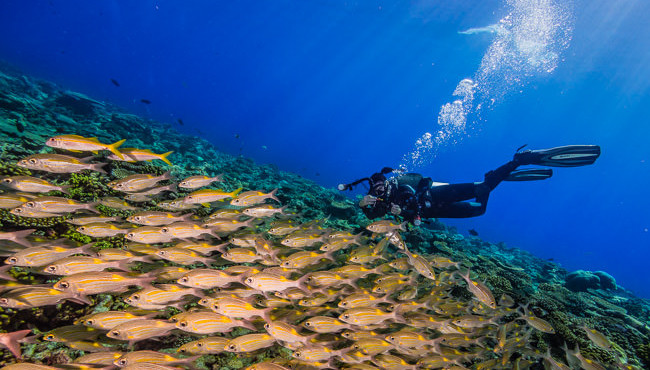
Why so blue?
In part one of our series on Available Light, I looked at why wide angle lenses are such a deal breaker when trying to get great available light in underwater pictures.
Wide angle lenses are only part of the solution though, and a two pronged assault on the flat, blue problem pictures is what is needed.
We’ve established how you need to get much closer to your subject hence the wide angle lens, but we also need to address the lack of colour that will blight a lot of underwater shots.
We see a multicoloured vibrant reef, resplendent with hard and soft corals, populated by a variety of fish in a myriad of hues. Yet why do our pictures end up as just fifty shades of blue?
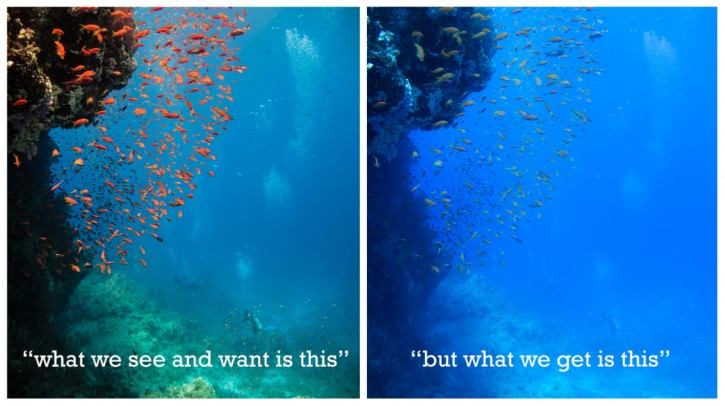
Our perception of what we are seeing is one of the main issues in available light underwater photography. So using Custom White Balance allows us to take back control of the situation.
What’s going on?
It helps if we understand a little of what is happening. As we descend the colours are filtered out progressively more as we leave the surface, with the reds and oranges disappearing first followed by the yellows then greens as we approach the relatively modest depths of 15 to 20 metres.
In our minds eyes though, especially nearer to the surface, we “experience” these colours because our brains are tricking us a little. Our cameras though see things as they really are, which is why folk are often disappointed with their first foray into underwater photography.
Pre-digital cameras, we had little alternative than to use strobes or flashguns to replace the colours in our shots.
With the advent of digital though came a new option to control the colour temperature in our pictures, and for each and every shot if we wished.
This opened the door to a whole load of exciting new possibilities for us underwater photographers, and this was called Custom or Manual White Balance.
Setting the right balance
Most digital cameras these days have an option to control the colours of their end results. This is accessed using the menu controls, and is normally a bunch of symbols under the heading of white balance. It’s very difficult to be specific here, as each brand, and even individual models of camera, are often different in this respect. If you’re not sure with your camera, or are thinking of buying a suitable camera once again, get in touch at duxy@scubatravel.com and I will advise you on the current choices.
With beginners this is the single most popular thing I start folk off with on our photo workshops.
When you find the White Balance menu on your particular camera you need to find the symbol in the middle. After accessing it your camera will tell you what to do onscreen. I can’t be more specific because it differs widely from camera to camera.
It’s usually the turning point when they realise that they are able to get great colourful underwater pictures. Here’s a selection of white balanced photos and videos that I shot with compact cameras from across the years:
https://www.youtube.com/watch?v=_V9UUQTSDpk
OK, hopefully that’s shown you that this is a valid technique for putting some colours back in your pictures.
How to do this is the big question though.
As I mentioned, most cameras are very specific with their means to correctly White Balance, but generally speaking the procedure requires you to show the camera a reference “white”. This can actually be a neutral mid grey tone too – a slate is one solution.
Or I tend to just use my hand (see below). You don’t need to fill the whole frame with your hand; better still to hold it at around the distance your foreground interest will be.
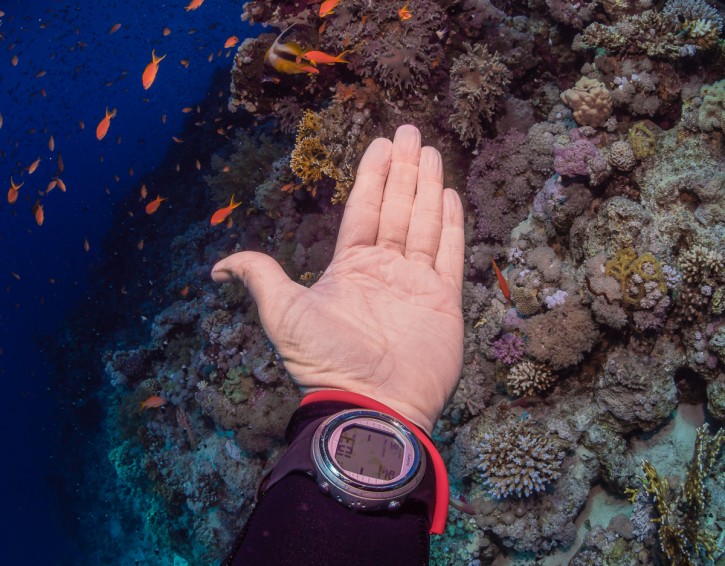
This is the usual distance and size in the frame of my hand when taking a white balance reading. I try and replicate the angle and depth at which I am shooting as accurately as possible too.
Follow and read your instruction book
And then you nearly always follow some onscreen instructions to take the reading.
What is clever here is that the camera will try and bring back the neutral mid grey or white back to what it should be, and hopefully then any colour cast, i.e. the blue of the water, will stop affecting the colours in your shots.
As you go deeper you need to take further readings, as the depth that you are at effects the white balance quite markedly.
Distance from subject is also an issue, so it helps to factor in this when you take the reading.
OK – if you follow this procedure in an ideal world and with the conditions in your favour, you’ll get great colourful pictures. Unfortunately we don’t live in a perfect world, and Custom White Balance doesn’t always provide such a simple solution.
So in the next instalment of this four part series we’ll look at some of the pitfalls to Custom White Balance, and in what circumstances it works best, and more importantly what circumstances it doesn’t work too well with.
[hr style=”single”]
 Duxy is the in house photo-pro for UK-based dive tour operator Scuba Travel. To find out about availability on Scuba Travel’s underwater photography workshops hosted by Duxy click here.
Duxy is the in house photo-pro for UK-based dive tour operator Scuba Travel. To find out about availability on Scuba Travel’s underwater photography workshops hosted by Duxy click here.
Blogs
Diver Discovering Whale Skeletons Beneath Ice Judged World’s Best Underwater Photograph
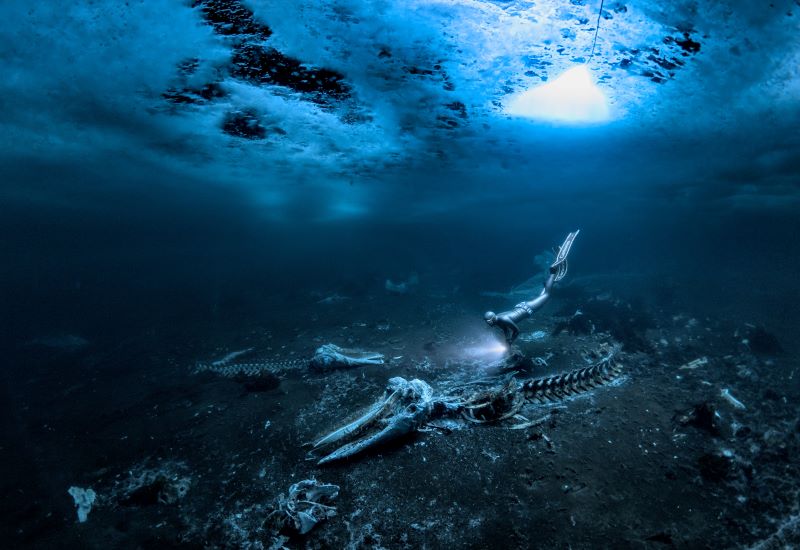
An emotive photograph showing a freediver examining the aftermath of whaling sees
Alex Dawson from Sweden named Underwater Photographer of the Year 2024. Dawson’s
photograph ‘Whale Bones’ triumphed over 6500 underwater pictures entered by underwater
photographers from around the world.
“Whale Bones was photographed in the toughest conditions,” explains chair of judging
panel Alex Mustard, “as a breath-hold diver descends below the Greenland ice sheet to bear
witness to the carcasses. The composition invites us to consider our impact on the great
creatures of this planet. Since the rise of humans, wild animals have declined by 85%. Today,
just 4% of mammals are wildlife, the remaining 96% are humans and our livestock. Our way
needs to change to find a balance with nature.”
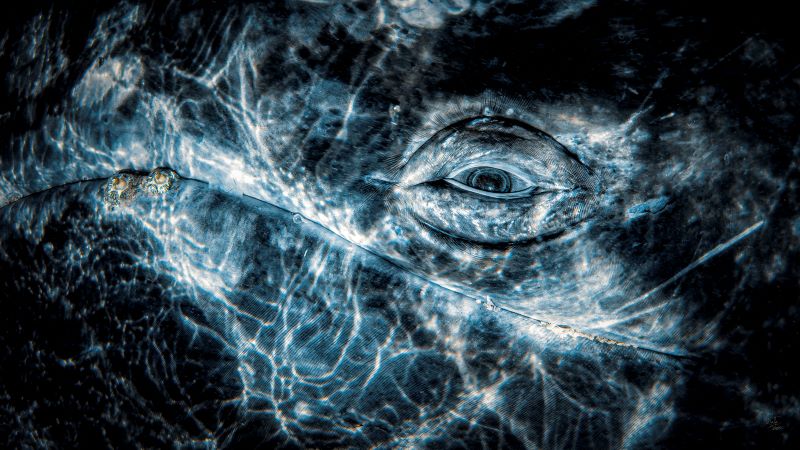
Photo: Rafael
Fernandez Caballero
Whales dominated the winning pictures this year with Spanish photographer Rafael
Fernandez Caballero winning two categories with his revealing photos of these ocean giants:
a close up of a grey whale’s eye and an action shot of a Bryde’s whale engulfing an entire bait
ball, both taken in Magdalena Bay, Baja California, Mexico. Fernandez Caballero took ‘Grey
Whale Connection’ while drifting in a small boat, holding his camera over the side in the water
to photograph the curious whale. ‘The End Of A Baitball’ required Fernandez Caballero to dive
down and be in exactly the right place at the moment the whale lunged. “The photo shows
the high speed attack,” he said, “with the whale engulfing hundreds of kilograms of sardines
in one bite — simply unforgettable to see predation on such a scale.”
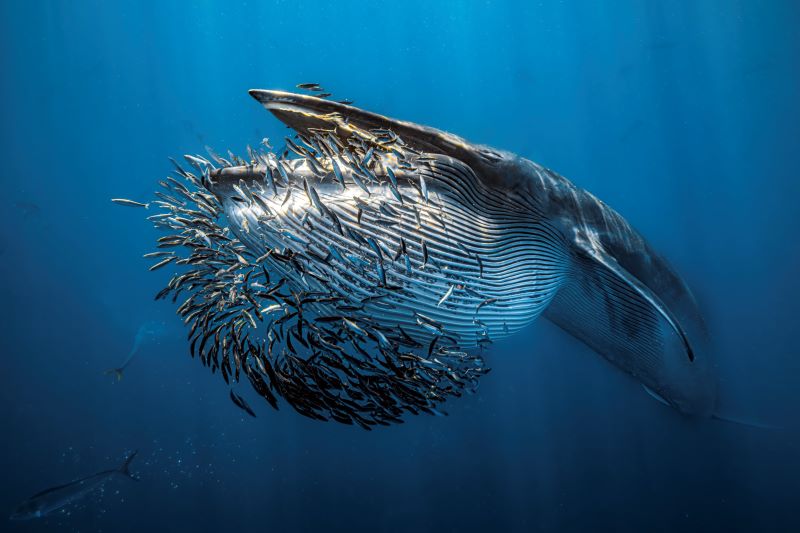
Photo: Rafael
Fernandez Caballero
Lisa Stengel from the United States was named Up & Coming Underwater Photographer of the Year 2024 for her image of a mahi-mahi catching a sardine, in Mexico. Stengel used both a very fast shutter speed and her hearing to catch the moment. “If you listen there’s an enormous amount of sound in the ocean,” she explained. “The action was too fast to see, so I honed in on the sound of the attacks with my camera to capture this special moment.”
“It is such an exciting time in underwater photography because photographers are capturing such amazing new images, by visiting new locations and using the latest cameras,”
commented judge Alex Mustard. “Until this year I’d hardly ever see a photo of a mahi mahi,
now Lisa has photographed one hunting, action that plays out in the blink of an eye.”
The Underwater Photographer of the Year contest is based in the UK, and Jenny Stock,
was named as British Underwater Photographer of the Year 2024 for her image “Star
Attraction”, which finds beauty in species of British wildlife that are often overlooked.
Exploring the west coast of Scotland, Stock explained “in the dark green depths my torch
picked out the vivid colours of a living carpet of thousands of brittle stars, each with a
different pattern. I was happily snapping away, when I spotted this purple sea urchin and I
got really excited.”
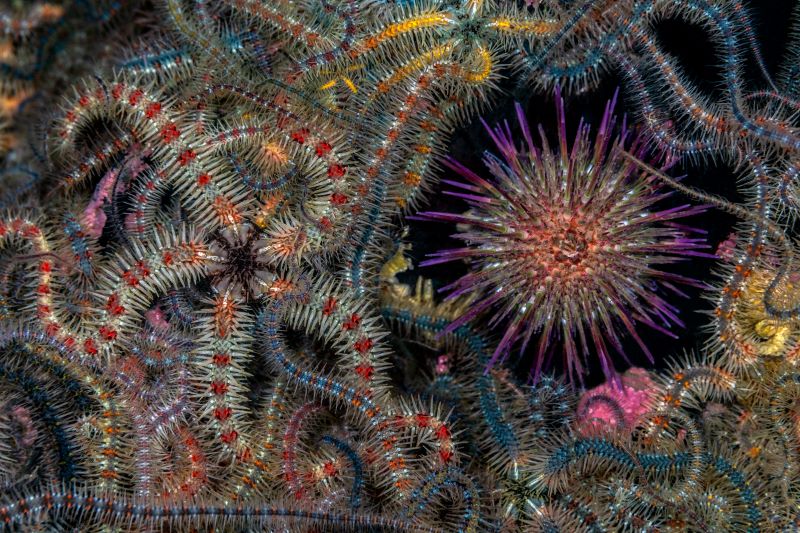
Photo: Jenny Stock
In the same contest, Portuguese photographer, Nuno Sá, was named ‘Save Our Seas
Foundation’ Marine Conservation Photographer of the Year 2024, with his photo ‘Saving
Goliath’, taken in Portugal. Sá’s photo shows beachgoers trying to save a stranded sperm
whale. The picture gives us hope that people do care and want to help the oceans, but also
warns us that bigger changes are needed. “The whale had been struck by a ship and its fate
was sealed,” explains Sá. “An estimated 20,000 whales are killed every year, and many more
injured, after being struck by ships-and few people even realise that it happens.”
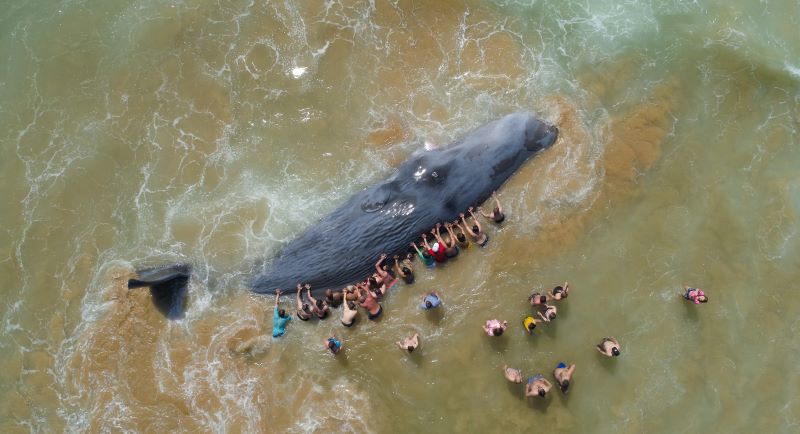
Photo: Nuno Sá
More winning images can be found at www.underwaterphotographeroftheyear.com.
About Underwater Photographer of the Year
Underwater Photographer of the Year is an annual competition, based in the UK, that celebrates photography beneath the surface of the ocean, lakes, rivers and even swimming pools, and attracts entries from all around the world. The contest has 13 categories, testing photographers with themes such as Macro, Wide Angle, Behaviour and Wreck photography, as well as four categories for photos taken specifically in British waters. The winners were announced in an award ceremony in Mayfair, London, hosted by The Crown Estate. This year’s UPY judges were experienced underwater photographers Peter Rowlands, Tobias Friedrich and Dr Alexander Mustard MBE.
Header image: Underwater Photographer of the Year 2024 winner Alex Dawson
News
World’s Best Underwater Photographers Unveil Breathtaking Images at World Shootout 2023
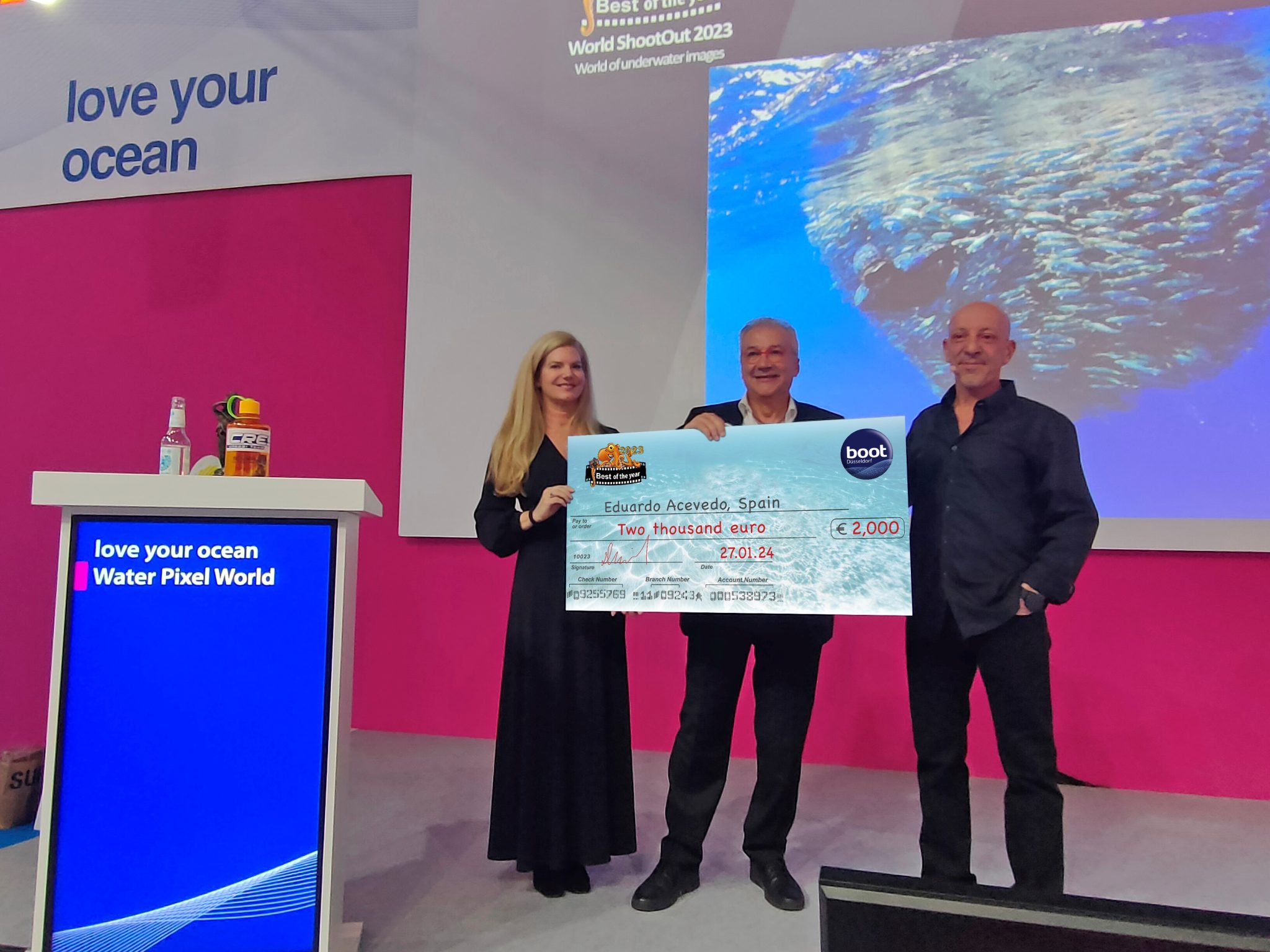
The winners of the prestigious World Shootout 2023 underwater photography competition were announced at this year’s BOOT Show, captivating audiences at the world’s largest diving and water sports exhibition in Dusseldorf, Germany. Hundreds of photographers from 54 countries competed across nine categories, pushing the boundaries of creativity and technical skill.
Grand Prize Winners
- Picture of the Year: Spanish photographer Eduardo Acevedo “secured” the top Honor with the prestigious prize the “boot Dusseldorf Director’s Prize, earning an Andromeda statuette and a €2,000 cash prize.
- Best 5 Images Portfolio: Luc Rooman from Belgium triumphed in this category, winning a dream 4-week diving trip for two to Papua New Guinea, valued at $18,900.
- Amateur Photographer: Alexandra Ceurvorst from the USA impressed the judges with her talent, taking home the 1,000 € cash prize award.
Celebrating Diversity and Innovation
This year’s competition saw 11,680 entries from 964 photographers, showcasing a remarkable spectrum of skills and perspectives. From the intricate wonders of Macro photography to the beauty of “Black Water”, the “Underwater Fashion” category added a touch of artistry and innovation, while the ever-important ” Environmental & Conservation” category served as a powerful reminder of the need to protect these fragile ecosystems.
Looking Ahead: AI and Ocean Conservation
World Shootout founder and producer David Pilosof unveiled an exciting addition for the 2024 competition: this year the Environmental category will be focusing on the impact of plastic on our oceans and future.
This category will embrace the potential of AI or other editing software as a tool to amplify the conservation message.
Entrants will submit campaigns of three original underwater photographs dealing with plastic pollution, along with their final AI assistance processing. This innovative approach encourages artistic expression while raising awareness about a critical environmental issue.
Explore the Stunning Collection
Discover the complete album of competition entries by clicking here.
For Low-resolution photos of finalist entries in eight categories, click here.
-

 News3 months ago
News3 months agoHone your underwater photography skills with Alphamarine Photography at Red Sea Diving Safari in March
-

 News2 months ago
News2 months agoCapturing Critters in Lembeh Underwater Photography Workshop 2024: Event Roundup
-

 Marine Life & Conservation Blogs2 months ago
Marine Life & Conservation Blogs2 months agoCreature Feature: Swell Sharks
-

 Blogs2 months ago
Blogs2 months agoMurex Resorts: Passport to Paradise!
-

 Blogs2 months ago
Blogs2 months agoDiver Discovering Whale Skeletons Beneath Ice Judged World’s Best Underwater Photograph
-

 Gear News3 months ago
Gear News3 months agoBare X-Mission Drysuit: Ideal for Both Technical and Recreational Divers
-

 Gear Reviews2 months ago
Gear Reviews2 months agoGear Review: Oceanic+ Dive Housing for iPhone
-

 Marine Life & Conservation2 months ago
Marine Life & Conservation2 months agoSave the Manatee Club launches brand new webcams at Silver Springs State Park, Florida
















